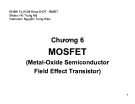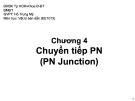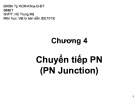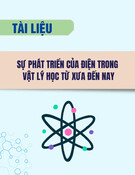
Chương 2
Di năng lưng và
nng đ ht dn cân bng nhit
ĐHBK Tp HCM-Khoa Đ-ĐT
BMĐT
GVPT: Hồ Trung Mỹ
Môn học: Vật lý bán dẫn (EE1013)

2
Ni dung
1. Vật liệu bán dẫn
2. Cấu trúc tinh thể cơ bản
3. K thuật tăng trưng tinh thể cơ bản
4. Liên kết hóa trị
5. Dải năng lượng
6. Nồng độ hạt dẫn nội tại
7. Các chất donor và acceptor.
8. Nồng độ hạt dẫn trong bán dẫn loại N và P

3
2.1 Vật liu bán dn
❑Kiểm soát (hay điều khiển) độ dẩn điện là chìa khóa
của các dụng cụ điện tử hiện đại
❑Phân loại vật liệu trạng thái rắn theo:
➢Điện tr suất/điện dẫn suất:
của cách điện < của bán dn < của dẫn điện
➢Cấu trúc: [đơn] tinh thể, đa tinh thể, và vô định hình
➢Liên kết hóa học: liên kết kim loại, ion, đồng hóa trị và
van der Waals.
▪Bán dẫn nguyên tố: liên kết đồng hóa trị.
▪Hợp chất bán dẫn: liên kết đồng hóa trị và liên kết ion.
➢Khe năng lượng Eg (phần sau)

4
Control of Conductivity is the Key to
Modern Electronic Devices
Conductivity, σ, is the ease with which a given
material conducts electricity.
Ohms Law: V=IR or J=σE where J is current density
and E is electric field.
◼Metals: High conductivity
◼Insulators: Low Conductivity
◼Semiconductors: Conductivity can be varied by several
orders of magnitude.
It is the ability to control conductivity that make
semiconductors useful as “current/voltage control
elements”. “Current/Voltage control” is the key to
switches (digital logic including microprocessors
etc…), amplifiers, LEDs, LASERs, photodetectors,
etc...

5
Classifications of Electronic Materials
Electrical/Computer engineers like to classify materials based
on electrical behavior (insulating, semi-insulating, and
metals).
Materials Engineers/Scientists classify materials based on
bond type (covalent, ionic, metallic, or van der Waals), or
structure (crystalline, polycrystalline, amorphous, etc...).
In 20-50 years, EE’s may not be using semiconductors at all!!
Polymers or bio-electronics may replace them! However the
materials science will be the same!




















![Bộ câu hỏi lý thuyết Vật lý đại cương 2 [chuẩn nhất/mới nhất]](https://cdn.tailieu.vn/images/document/thumbnail/2025/20251003/kimphuong1001/135x160/74511759476041.jpg)
![Bài giảng Vật lý đại cương Chương 4 Học viện Kỹ thuật mật mã [Chuẩn SEO]](https://cdn.tailieu.vn/images/document/thumbnail/2025/20250925/kimphuong1001/135x160/46461758790667.jpg)




